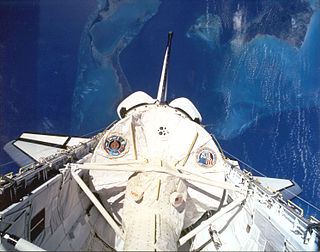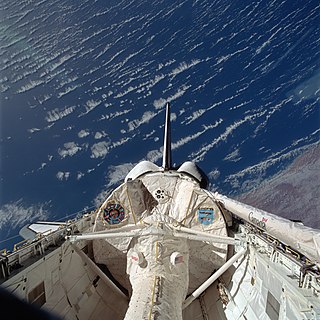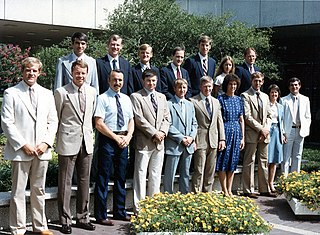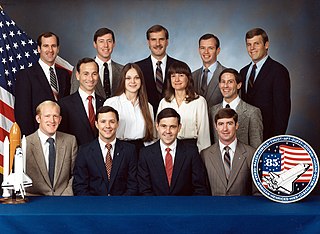
Spacelab was a reusable laboratory developed by European Space Agency (ESA) and used on certain spaceflights flown by the Space Shuttle. The laboratory comprised multiple components, including a pressurized module, an unpressurized carrier, and other related hardware housed in the Shuttle's cargo bay. The components were arranged in various configurations to meet the needs of each spaceflight.

Ulf Dietrich Merbold is a German physicist and astronaut who flew to space three times, becoming the first West German citizen in space and the first non-American to fly on a NASA spacecraft. Merbold flew on two Space Shuttle missions and on a Russian mission to the space station Mir, spending a total of 49 days in space.

STS-50 was a NASA Space Shuttle mission, the 12th mission of the Columbia orbiter. Columbia landed at Kennedy Space Center for the first time ever due to bad weather at Edwards Air Force Base caused by the remnants of Hurricane Darby.

Taylor Gun-Jin Wang is a Chinese-born American scientist and in 1985, became the first person of Chinese origin to go into space. While an employee of the Jet Propulsion Laboratory, Wang was a payload specialist on the Space Shuttle Challenger mission STS-51-B.

STS-51-B was the 17th flight of the NASA Space Shuttle program and the seventh flight of Space Shuttle Challenger. The launch of Challenger on April 29, 1985, was delayed by 2 minutes and 18 seconds, due to a launch processing failure. Challenger was initially rolled out to the pad to launch on the STS-51-E mission. The shuttle was rolled back when a timing issue emerged with the TDRS-B satellite. When STS-51-E was canceled, Challenger was remanifested with the STS-51-B payloads. The shuttle landed successfully on May 6, 1985, after a week-long mission.

STS-42 was a NASA Space Shuttle Discovery mission with the Spacelab module. Liftoff was originally scheduled for 8:45 EST on January 22, 1992, but the launch was delayed due to weather constraints. Discovery successfully lifted off an hour later at 9:52:33 EST. The main goal of the mission was to study the effects of microgravity on a variety of organisms. The shuttle landed at 8:07:17 PST on January 30, 1992, on Runway 22, Edwards Air Force Base, California. STS-42 was the first of two flights in 1992 of Discovery, the second of which occurred during STS-53, which launched on December 2, 1992. The mission was also the last mission of the Space Shuttle Discovery to have a seven-member crew until STS-82, which was launched on February 11, 1997.

STS-47 was NASA's 50th Space Shuttle mission of the program, as well as the second mission of the Space Shuttle Endeavour. The mission mainly involved conducting experiments in life and material sciences inside Spacelab-J, a collaborative laboratory inside the shuttle's payload bay sponsored by NASA and the National Space Development Agency of Japan (NASDA). This mission carried Mamoru Mohri, the first Japanese astronaut aboard the shuttle, Mae Jemison, the first African-American woman to go to space, and the only married couple to fly together on the shuttle, Mark C. Lee and Jan Davis, contrary to NASA policy.

STS-54 was a NASA Space Transportation System mission using Space Shuttle Endeavour. This was the third flight for Endeavour, and was launched on January 13, 1993 with Endeavour returning to the Kennedy Space Center on January 19, 1993.

STS-73 was a Space Shuttle program mission, during October–November 1995, on board the Space Shuttle Columbia. The mission was the second mission for the United States Microgravity Laboratory. The crew, who spent 16 days in space, were broken up into 2 teams, the red team and the blue team. The mission also included several Detailed Test Objectives or DTO's.

STS-83 was a NASA Space Shuttle mission flown by Columbia. It was a science research mission that achieved orbit successfully, but the planned duration was a failure due to a technical problem with a fuel cell that resulted in the abort of the 15 day duration. Columbia returned to Earth just shy of four days. The mission was re-flown as STS-94 with the same crew later that year.

STS-94 was a mission of the United States Space Shuttle Columbia, launched on 1 July 1997.

Roger Keith Crouch is an American scientist and astronaut who flew as a payload specialist on two NASA Space Shuttle missions in 1997.

Dirk Dries David Damiaan, Viscount Frimout is an astrophysicist for the European Space Agency. He flew aboard NASA Space Shuttle mission STS-45 as a payload specialist, making him the first Belgian in space.

Michael Landon Gernhardt is a NASA astronaut and manager of the Environmental Physiology Laboratory, and principal investigator of the Prebreathe Reduction Program (PRP) at the Lyndon B. Johnson Space Center.

Fred Weldon Leslie is an American scientist who flew on the NASA STS-73 Space Shuttle mission as a payload specialist.

Donald Alan Thomas is an American engineer and a former NASA astronaut.

Susan Kilrain is an American aerospace engineer, former United States Navy officer, and a former NASA astronaut. She is the youngest person to pilot a Space Shuttle. She has flown more than 3,000 hours and among her merits she was awarded with the Defense Superior Service Medal.

NASA Astronaut Group 10 was a group of 17 astronauts that were announced on May 23, 1984 and consisted of seven pilots and ten mission specialists. Although selected in 1984, no member of the group would fly until 1988 due to the Challenger disaster and the resulting grounding of the Space Shuttle fleet.

NASA Astronaut Group 11 was a group of 13 NASA astronauts announced on 4 June 1985.

Mary Helen Johnston, later also Mary Helen McCay, is an American scientist and former astronaut. Working with NASA as an engineer in the 1960s and '70s, Johnston aspired to be an astronaut; she unsuccessfully applied in 1980 before becoming a payload specialist in 1983. Johnston retired from NASA in 1986 without having gone to space. She is a professor at Florida Institute of Technology.




















